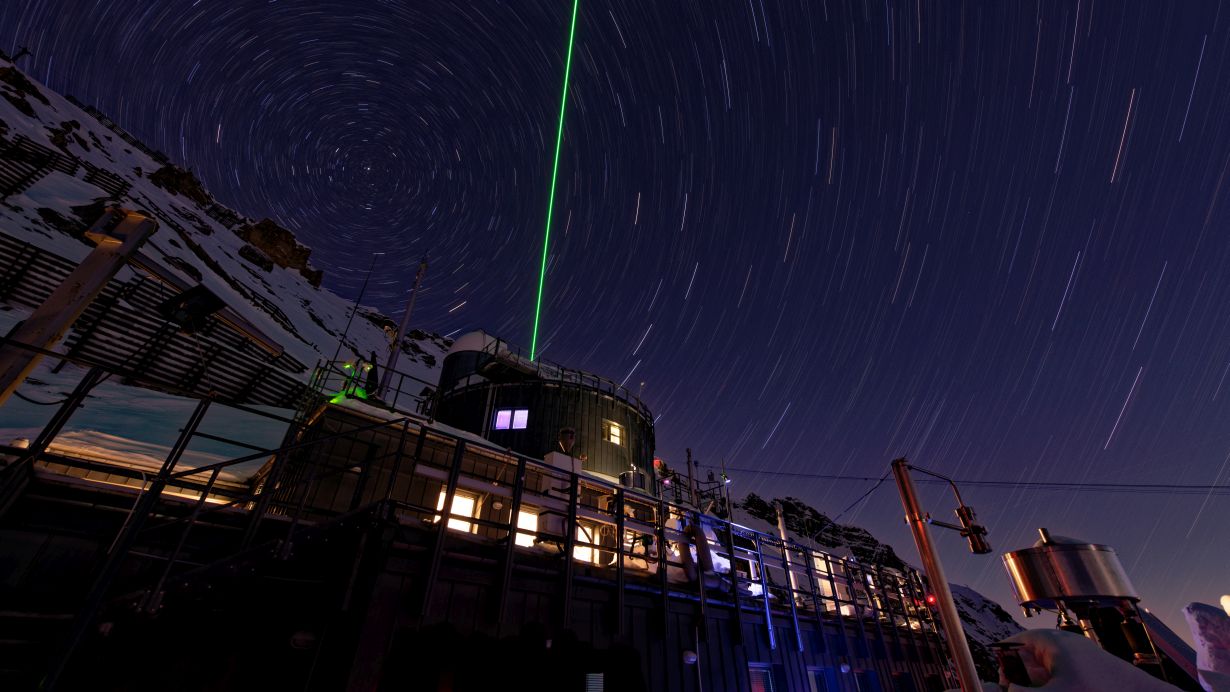
The German ACTRIS-D infrastructure is designed to explore short-lived constituents of the atmosphere from the ground up to the stratosphere and to help researchers reduce uncertainties in future climate forecasts. One of the partners of ACTRIS-D is Karlsruhe Institute of Technology (KIT). The goal is to obtain new findings about the interactions of different climate processes and to evaluate measures taken to improve air quality and their effects on health and ecosystems. Within ACTRIS-D, KIT is granted about EUR 14 million to set up new measurement systems for cloud research and to extend and upgrade existing facilities, such as the AIDA cloud chamber and the atmosphere observatory on the Zugspitze summit near Garmisch-Partenkirchen.
Fine dust particles, clouds, and most trace gases are short-lived constituents of the atmosphere. Contrary to the long-lived greenhouse gases of methane and carbon dioxide that remain in the atmosphere for tens to thousands of years, short-lived substances stay there for a few hours to weeks only. Still, they have a big impact on air quality and climate. Small suspended particles reflect sunlight and thermal radiation or initiate the formation of cloud droplets and ice crystals, which may lead to precipitation. Little is known about how big these very different effects are.
"Climate change is a big, challenging task that requires a joint effort - across institutions and countries. ACTRIS-D will use latest measurement technologies to collect new data, analyze them in the worldwide community, and create knowledge for the society," says KIT President Professor Holger Hanselka. "KIT is excellently positioned in atmosphere research and will make an essential contribution to research in this area based on its know-how and top-level infrastructures."
Precise Measurement Data on the Distribution of Aerosols
"At KIT, we will collect precise and quality-checked data on trace gases, aerosols, and clouds over longer terms. This will improve our knowledge of important processes in the climate system and help to better understand and analyze future changes," says Dr. Ottmar Möhler from the Atmospheric Aerosol Research Department of KIT's Institute of Meteorology and Climate Research (IMK-AAF). "KIT is operating established infrastructures, including infrared and laser radar systems for ground-based remote sensing in Garmisch-Partenkirchen and on Zugspitze, the AIDA cloud simulation chamber on KIT's Campus North, and the mobile KIT-CUBE system." These facilities will be upgraded for long-term operation within ACTRIS-D.
Enhancing Performance in Atmosphere Research
The atmosphere observatories at Garmisch-Partenkirchen, on Zugspitze, and at the Schneefernerhaus research station measure concentrations of trace gases, including ozone, ethane, formaldehyde, and nitrogen dioxide, in the atmosphere. Moreover, they determine vertical distributions of aerosols with highest temporal resolution and accuracy. For long-term operation, infrared spectrometers of maximum resolution and modern laser radar systems will be installed. Studies will focus on how air pollutants enter the boundary layer and higher atmosphere from the ground and how they are transported to other geographic areas. These atmosphere data will be used for controlling the quality of satellite-borne Earth observations.
Cloud formation and its impact on weather and climate are studied at the AIDA aerosol and cloud chamber. "Within the framework of ACTRIS, we will construct a new, more powerful cloud simulation chamber," Möhler says. "We want to reach even lower temperatures and air pressures to study trace gas, aerosol, and cloud processes throughout the atmosphere under controlled experimental conditions."
The mobile Karlsruhe Low-cloud Exploratory Platform KLOCX will provide scientists with new insights into the formation and dissolution of lower clouds. These clouds reflect sunlight back into space, but also hold back the Earth's thermal radiation. One of the big questions of current climate research is how strong these effects are under which conditions. Ground-based remote sensing measurements of KLOCX and satellite observations will concentrate on these low cloud and fog development processes.
In addition, KIT will set up and direct the calibration center CIS - Centre for Cloud In-situ Measurements. The CIS consortium is one of six European centers specialized in remote sensing and in-situ studies of aerosols, clouds, and trace gases.
ACTRIS Will Focus on Short-lived Atmospheric Substances
ACTRIS (The Aerosol, Clouds, and Trace Gases Research Infrastructure) will comprise several research institutions to study short-lived atmospheric constituents and enhance Earth system observation and research from 2022. Under the "Research for Sustainability" (FONA) program, the Federal Ministry of Education and Research will fund the German contribution ACTRIS-D with a total of EUR 86 million in the next eight years. ACTRIS-D will be coordinated by the Leibniz Institute for Tropospheric Research (TROPOS) in Leipzig. The funds will be used to extend or newly build several stationary and mobile measurement stations, laboratories, and simulation chambers.
More than 100 research institutions from 22 countries in Europe are involved in ACTRIS. The ACTRIS network spans more than 70 observatories in Europe as well as stations in polar regions, the tropics, and in Asia. ACTRIS will provide many users with efficient access to data, resources, and services, the goal being to enable high-quality Earth system research. (swi)
More Activities of KIT in ACTRIS: https://www.kit.edu/kit/english/pi_2021_002_leading-role-of-kit-in-cloud-observation.php
More about the KIT Climate and Environment Center: https://www.klima-umwelt.kit.edu/english/
Being "The Research University in the Helmholtz Association", KIT creates and imparts knowledge for the society and the environment. It is the objective to make significant contributions to the global challenges in the fields of energy, mobility, and information. For this, about 9,600 employees cooperate in a broad range of disciplines in natural sciences, engineering sciences, economics, and the humanities and social sciences. KIT prepares its 23,300 students for responsible tasks in society, industry, and science by offering research-based study programs. Innovation efforts at KIT build a bridge between important scientific findings and their application for the benefit of society, economic prosperity, and the preservation of our natural basis of life. KIT is one of the German universities of excellence.






